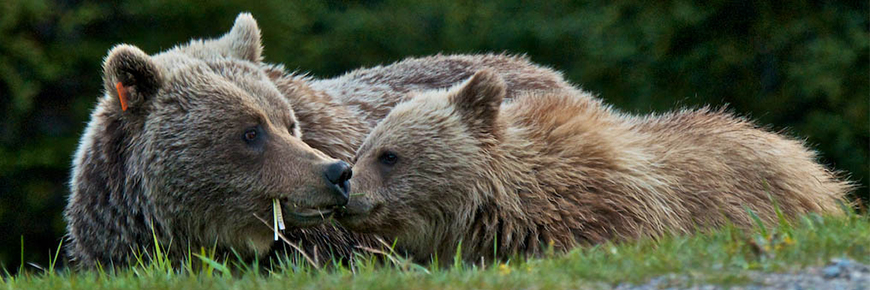
Bear basics
Bears in the mountain national parks
Grizzly bears and black bears—two distinct bear species in the Canadian Rocky Mountains, yet sometimes tricky to tell apart—especially at a quick glance.
Black bears
In North America, the black bear (Ursus americanus) once ranged throughout forested areas across most of North America, from the east coast to the west...
Grizzly Bears
In North America, grizzly bears (Ursus arctos) once ranged from the Pacific Ocean to the Mississippi River and from Central Mexico to the Arctic Ocean.
Comparing Black Bears and Grizzly Bears
Parks Canada wildlife specialists collect data on where bears spend their time in the national parks. If you are visiting here, you can help our conservation efforts by reporting your bear sightings. Knowing the difference between a grizzly bear and a black bear is helpful information.
Here are some tips to help you become an expert bear-spotter:
Colour
Many people think that if a bear is black it must be a black bear and if it is brown it must be a grizzly bear. The truth is, both species come in a variety of shades. Colour alone is not a good indicator of species.
- The species we refer to here in western North America as the grizzly bear is found throughout the northern hemisphere in places like Japan, Europe, Asia and Scandinavia, where it is commonly referred to as the brown bear. Although they are often brown, grizzly bears can range in colour from jet black to light blond.
- Many grizzly bears have natural highlights. Frosted tips on their hair give them a grizzled look, hence the name.
- Black bears range in colour from blond, and even white in some circumstances, to brown, cinnamon, and black.
- You often see a black bear with a white patch on its chest, called a chest blaze.
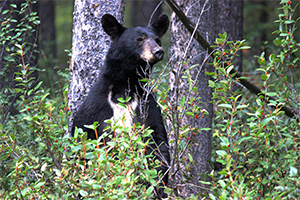
Black bear with chest blaze
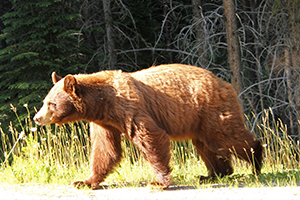
Black bear with colour variation
Size
Bears in the Rocky Mountain national parks are generally smaller than those found in other regions of North America. Grizzly bears are typically bigger than black bears, but female grizzlies and male black bears can weigh the same, so don’t rely on size alone to tell them apart. Bears here on average weigh in at:
- Male grizzlies: 150-300 kg
- Female grizzlies: 80-150 kg
- Male black bears: 80-150 kg
- Female black bears: 45-100 kg
Shape
- Grizzly bears have a very prominent muscle mass over their shoulders that creates a noticeable hump.
- The rump is lower than the shoulders on a grizzly.
- The shoulder hump is not prominent in black bears.
- The rump is higher than the shoulders on a black bear.
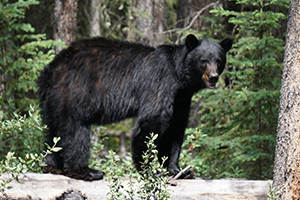
Black bears have higher rumps
and no massive shoulder hump
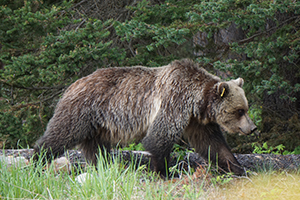
Grizzly bears have a
noticeable shoulder hump
Head
- A grizzly bear has a large, round head and a dished or concave face.
- A black bear has a smaller head with an elongated snout. When you look at a black bear from the side, its head and snout form a straight line.

Black bear profile with
straight head and snout

Grizzly bear profile with concave face
Ears
- Grizzly bear ears are short, round and set well apart.
- Black bear ears are more prominent, being longer and pointier.
Claws
- Grizzly bears have long, curved claws (5-10 cm) used for digging in the ground for roots, insects and ground squirrels.
- Grizzly bear claws vary in colour from white to dark with light streaks.
- When looking at grizzly bear tracks, claws marks are evident 5 cm or more in front of the toes.
- Black bears have short, black claws (3-4 cm), great for climbing trees.
- Claw marks are not always visible in black bear tracks; if you do see them, they are close to the toes.
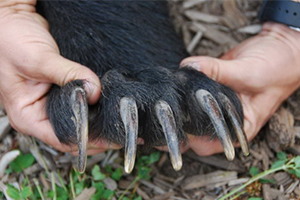
Related links
- Date modified :